I believe art counts. I believe in its delicious, fibrous, textural insights. In the way it helps us understand the complexity of ourselves. I want to be a part of that. I step away for a deep breath, and I’m at it again. – Nicole Livieratos
This past Saturday I saw Origami at the Inman Park White Space gallery – a solo performance work by Nicole Livieratos with direction by Patricia Henritze. The partnership functions under the umbrellas of Livieratos’s Decatur based Garden House Dance and Proximity, their ongoing series of works. In talking to the two women after the performance, I discovered that Livieratos works with local schools to get kids moving (do they ever leave their computers anymore?) and collaborates with teachers in varied curricula; physics, chemistry, languages, on movement-based lessons.
Henritze said that their intent with this series is to make the type of performance work they do more accessible, and by offering small sequences to incorporate art into more of our daily routine. Susan Bridges generously donated her space for the free performance that was scheduled for 15 minutes each at noon, 2pm, 4pm and 6pm on both weekend days. I attended the first at noon.
The intimate setting was the back room of White Space, the perimeter fitted out with chairs for the audience that included a couple of young and rapt children. Interactivity with the spectators included spoken word, projected text from a Bob Hicok poem and multitudes of white paper boats, a few of which the performer gave to lucky folks at the end.
The performance evoked memories, proximity (of where we all are in our lives) and mortality. Origami offered both solemnity and wit in the dancer’s interaction with the audience, and the interpretation of poetry through her juxtaposition of fluid and deliberate movements.
Although it may be difficult to literally ‘get’ a poem or text through a single performance, these lines could have been an obvious reason for why Ms. Livieratos initially chose Hicok’s work:
Livieratos began the performance by asking us to close our eyes and only open them when she instructed. Sitting in a chair, she clasped her heart hard three times, then reached out to the audience. As she walked and swung a basket (of paper boats?) across the floor, she spoke a fragment of the poem, “I cried”, to her own sound effect of wind rushing by.
These are my notes, since I forgot to pack my camera –
2, 3, 2, 3, 2, 3 – Performer is speaking the numbers in fast succession. She empties the bucket of paper boats and carries one boat as if she were on the sea, walking slowly and waving her open palm with the little boat bobbing gently up and down.
Crouches down with hands on floor, slowly picks up boats and places them on her back, walking across floor, bent over, while sound effects of glass breaking plays on an iPod.
all photos above by R.L. Humphreys.
She crawls slowly on her stomach toward us with an outstretched arm, opening and closing her hand – an offering? The dancer now carefully walks on the small white boats, covering her eyes. Then she moves rhythmically to an operatic aria, and finally skips a stone across the brick floor.
I was fortunate enough to receive a part of the poem handed out during the performance; I don’t know what that something is but it would be free.  I couldn’t help but think of Eiko and Koma’s emotionally charged work, both moving so excruciatingly slowly on a stage floor in an early San Francisco performance.
These pieces bring us closer to the connectedness and spirituality of body as art. Art as the freedom to act, to take risks and the coincidence of everyday circumstances that intervene and cross into it. All combine to make beauty that is both ephemeral and lasting beyond a single fifteen minute timeframe.
photos courtesy Mark Teague
photo courtesy Doug Hall.
History of Origami, by Bob Hicok.

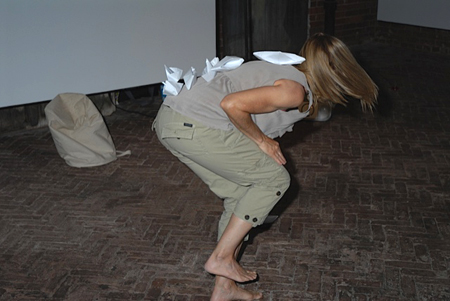

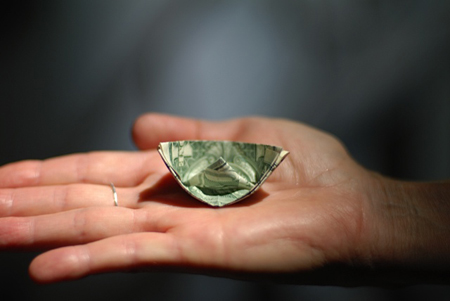
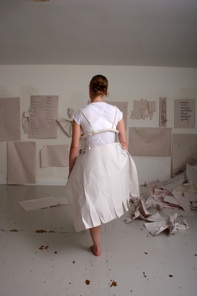
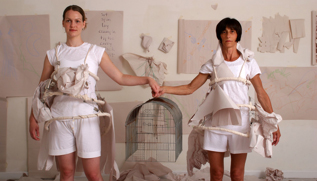
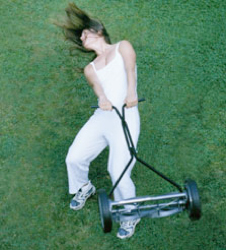
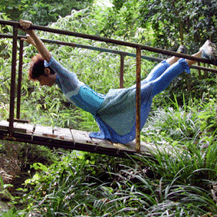
Victoria- Just read your piece on Nicole’s showing of Origami- such a pleasure- art writing/criticism is so bankrupt these days, I recently had begun to forget that there are some really thoughtful people out there. Many thanks. Also- in the small world department, Eiko and Koma are in today’s NY Times- a good friend of ours is mentioned as the lighting designer (Kathy Kaufmann).
Best,
Alan
Thanks Alan. It was a provocative and lovely performance, I look forward to more.
And an exhibit of yours as well!
Saw the E & K piece too.
-V
I took the picture of Chatov’s whistling angles on November 11, 2010 at Mason Murer